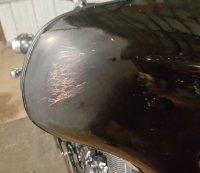IF that is gelcoat, your biggest problem is gonna be getting rid of the halo if you spray a lacquer. gelcoat and lacquer are gonna polish at different rates.
I’ve had the best luck doing spot repairs on gelcoat with an acrylic clear if i am spraying them. (I do a TON of them). And use an airbrush.
also, if you can get that filler out and redo with the same filler but adding a black pigment to the base (making the filler black) you will probably have a better end product as you can use less paint when blending.
also, if that’s a gelcoat - black is pretty much black with gelcoat unless it’s a custom mix which I highly doubt, you could use gelcoat and pigment to fix it and get a hardly noticeable end product. Skim it with a black pigmented gelcoat, sand and polish
you can also reduce gelcoat and spray it out of an air brush after you fill. Then sand and polish.
as I’m sure you know, two people can do the same thing with wildly different outcomes when it comes to artistic repairs. Their tends to be general guidelines but no ABC hard fast rules and much about a good end is very nuanced. More about the Indian than the arrow.




